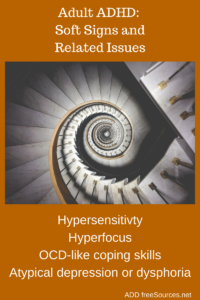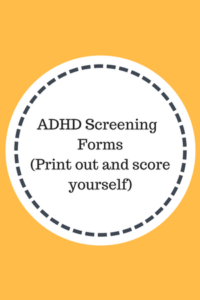ADHD in adults has many symptoms. The ones that are usually associated with ADHD may be easily recognized, but there are others that look like or create additional problems that can rise to the level of separate psychiatric disorders if not managed carefully.
As an Adult ADHD specialist and an adult with ADHD, I am quite familiar with these soft signs. They are not usually found in the diagnostic manuals, like the DSM-V, but experts in the field of ADHD write and teach about them. This is another reason it is so helpful to see an Adult ADHD specialist if you need help learning to manage the symptoms. Specialists have more training than just a couple of seminars about ADHD.
To find a true Adult ADHD specialist, you might want to ask questions about the person’s training and experience in the area of Adult ADHD. You might ask them how much specific training they have in adult ADHD (different from children’s ADHD) and how many clients they treat with Adult ADHD. Ideally, you can find someone who has significant experience and training in this field. (See Questions to Ask Before Scheduling an Appointment by Cynthia Hammer)
Other Lesser Known Symptoms of Adult ADHD
Some adults with ADHD may have recognized the ‘soft signs’ of ADHD in childhood and adolescence, but many do not acknowledge these (or confuse them with other problems) until adulthood. The following list is probably not all-inclusive but provides a good overview of the most common soft signs in the literature.
- Hypersensitivity/ Sensory Overload – Some people with ADHD find they are very emotionally sensitive. They feel their feelings strongly, and often take on the feelings of others. These folks are like sponges absorbing the emotions around them. They are often considered highly sensitive people, as defined by Elaine Aron, Ph.D.
Some people with ADHD are very sensitive to touch, the feel of certain fabrics and tactile experiences, ie. the texture of some foods. These people find it difficult to tolerate tags in their clothes, the feel of specific foods in their mouths, scratchy or otherwise uncomfortable fabrics. Tight clothing or the way it feels to wear shoes that have laces can be a miserable experience for some people with ADHD. Personally, I could not eat baby food and still don’t eat many foods with that texture. I also had quite a reaction to getting my hair brushed, wearing tight clothes, tags in clothes and other experiences.
Many people feel claustrophobic in crowds or areas where there is a lot of noise, light, etc. Places like airports, stadiums and other areas where there are too many people, lots of noise, bright lights and chaos can be overwhelming for us. (Yes, I have this symptom, too.)
There are a number of related psychiatric disorders that may overlap in symptoms. Some people with Adult ADHD have enough of the symptoms to meet the criteria for diagnosis with a coexisting or comorbid disorder, like social phobia, anxiety, panic-attacks or sensory processing disorder. Others find that if they can learn skills to manage or minimize these situations, they can deal with it using specific skills and techniques. They often do not meet the criteria for a separate disorder but suffer from these ADHD-related symptoms nonetheless. (For those who have clinical anxiety, it will need to be treated by someone who understands both anxiety disorders and ADHD.)
- Overwhelm or Overstimulation – Many adults with ADHD describe feelings similar to anxiety that are related to hypersensitivity. For those whose symptoms do not meet the criteria for a separate disorder, overwhelm and overstimulation are often more accurate descriptions of the problem. Laypersons throw around terms like anxiety and panic attack without much thought or awareness of the criteria for diagnosis. If a person with ADHD experiences these symptoms in isolated incidents, learning how to manage the symptoms is usually preferable to taking on an additional diagnosis and highly addictive anti-anxiety medication.
- OCD-like coping skills – (Obsessive Compulsive Disorder) Some people with ADHD develop obsessive-compulsive type coping skills to manage the chronic disorganization and feelings of being overwhelmed. These behaviors are a way of compensating for the messiness of ADHD, but can also create a lot of anxiety if the person becomes rigid in his/her approach to coping. An example would be someone who can’t begin homework or a project until everything is in the exact proper place on the desk. In those cases, a type of paralysis can develop that prevents them from doing anything productive other than obsessing about getting things in order.
True OCD is driven by anxiety – it is a form of anxiety disorder. OCD-like skills used to cope with ADHD is different but may result in anxiety. The messiness of ADHD creates anxiety for some people when it reaches a certain point of being out-of-control. For many, this is a way of building up enough energy to actually start on a project or chore. We literally allow enough time and chaos to ensure that we create stress.
When the stress reaches a crescendo, people with ADHD finally stop procrastinating and act – often due to a looming deadline that we can no longer ignore. Other times it is because the chaos reaches the point of anxiety or frustration. Feelings of anxiety may be the result – even though it is self-imposed or created. Some experts call this type of anxiety cognitive anxiety – thinking without acting on your thoughts also known as ruminating. Managing it requires learning to deal with the underlying ADHD symptoms of procrastination, time management, and executing tasks (instead of delaying starting or worrying for an extended period and not acting).
- Hyperfocus – Although it may be hard for us to get focused, once we get into something that triggers the dopamine we often get so focused we find it hard to stop or change tasks. This usually happens when we are doing something we really enjoy. For many, it happens when working on a project we are excited about, playing video games or getting pulled into social media. It happens to me with writing when the topic is something I know well and feel passionate about. (Which is why this article is getting so long!)
- Rejection Sensitive Dysphoria – Definitely not in the DSM-V, but a term coined by William Dodson, MD, one of the top experts in the field of ADHD. Dodson describes this as akin to atypical depression, which means it is not true depression but dysphoria, a term that means difficult to bear. In essence, Dodson has found with his patients a common theme of people who describe an internal state of arousal that prevents them from simply relaxing and enjoying life (hyperarousal vs. hyperactivity – remember after adolescence most of us show few symptoms of hyperactivity). The other commonality they reported is feeling devastated by failure or rejection. (See the first item in this list about hypersensitivity.)
This is an important distinction because Dodson links it to the differences in the ADHD nervous system, which he describes as hyperaroused. (Elaine Aron has found the same thing in people who are highly sensitive – a difference in central nervous processing). The literature is full of accounts of highly successful people with ADHD who report feeling ‘dysphoric’ when they experience failure or rejection. Behaviorists would have us believe that this reaction in adulthood stems from earlier experiences that trigger the emotions. Dodson says it is in the hard-wiring, and that about half of his patients have shown improvement with medication. This is worth noting as those who have this issue may want to consider talking to their medical provider about it now that they realize it may be ADHD-related.
It is important to know that some of these issues can be managed by learning to manage and/or treat ADHD effectively. 3 Defining Features of ADHD That Everyone Overlooks by William Dodson, MD from ADDitude Magazine further expands on other less well know symptoms of ADHD as well as how to recognize and manage an interest-based nervous system for starting, following through, and getting things done. This interest-based nervous system states that Interest, Urgency, Challenge, and Urgency are the keys to creating strategies for “turning on” the ADHD brain. A mnemonic device to remember these is “I see you now.” (I. for Interest, C for C.hallenge, You for U.rgency, and Now for N.ovelty.)
Treatment of ADHD is complicated – much more so than just taking a pill. Learn more about it in our Thriving with ADHD section. You can choose those articles or videos that meet your specific needs. Another article we have by this author covers additional methods in ADHD Success at College and Work.
___________________________________________________________________________________________________Resources
Matlen, Terri. “Too Loud, Too Bright, Too Sticky!” ADDitude Magazine, n.d. Web. June 9, 2018. www.additudemag.com/adhd-sensory-overload-spd-and-adhd-in-children
Dodson, William, MD. “Devastated by Disapproval.” ADDitude Magazine, n.d. Web. 12 Nov. 2013.
Dodson, William, MD. “The Fear of Failure is Real – and Profound,” ADDitude Magazine, n.d. Web June 9, 2018
Dodson, William, MD. “Rejection Sensitive Dysphoria” From Dodson’s website. n.d. Web June 9, 2018
 About the Author: LuAnn Pierce, LCSW has 30+ years in the field and is a guest author for a number of mental health-based websites. LuAnn offers solution-focused counseling to people in Colorado and Wyoming via teleconference or telephone. She also provides training and curriculum development to a variety of organizations. Contact Information: luannpierce@gmail.com
About the Author: LuAnn Pierce, LCSW has 30+ years in the field and is a guest author for a number of mental health-based websites. LuAnn offers solution-focused counseling to people in Colorado and Wyoming via teleconference or telephone. She also provides training and curriculum development to a variety of organizations. Contact Information: luannpierce@gmail.com
Original article, “Adult ADHD: Other Soft Signs and Related Issues,” is used with permission from LuAnn Pierce and Theravive: Find a therapist – “Our purpose is to help people everywhere find great counselors and psychologists. Everyone can have a new start in life.”
Photo by Ludde Lorentz on Unsplash Modified on Canva.com












